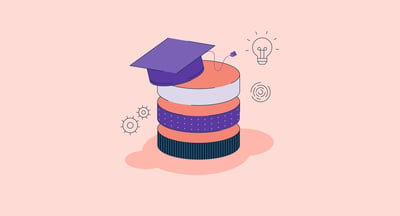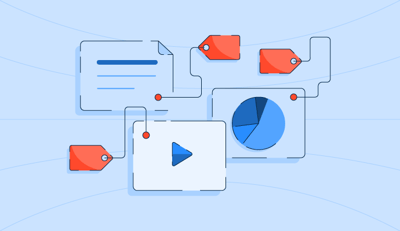December 20, 2024
 by Alyssa Towns / December 20, 2024
by Alyssa Towns / December 20, 2024

With the progression of advanced machine learning inventions, strategies like supervised and unsupervised learning are floating more in the market. While both of these technologies are effective to tackle big data, splitting the difference between supervised and unsupervised learning within machine learning software paves the way for accurate product analysis.
Supervised learning enables algorithms to predict unseen trends whereas unsupervised algorithms detect sentiments, anomalies or co-relations within the training data.
As both ML algorithms depend on what kind of training data is fed to the model, utilizing data labeling software maps the exact need of labeling services for predictive modeling.
Supervised learning is a process where labeled input data and labeled output data is fed inside the predictive modeling algorithm to forecast the class of unseen datasets. Unsupervised learning is a process where the dataset is raw, unstructured and unlabeled and newer data is classified based on attributes of unlabeled training data.
Supervised learning is a type of machine learning (ML) that uses labeled datasets to identify the patterns and relationships between input and output data. It requires labeled data that consists of inputs (or features) and outputs (categories or labels) to do so. Algorithms analyze the input information and then infer the desired output.
When it comes to supervised learning, we know what types of outputs we should expect, which helps the model determine what it believes is the correct answer.
Some of the most common applications of supervised learning are:
There are multiple methods of classification in supervised learning. For starters, the dataset is pre-processed, cleaned and evaluated for outliers. The labeled data establishes a strong correlation between a predicted variable and outcome variable.
Post data cleansing, the dataset is trained and tested on available labelled data to double check accuracy and classify unseen data. Based on prior training, here is how supervised learning is used to classify objects:
In binary classification, as mentioned earlier, the dataset is evaluated against hypothesis formation. It means that if A causes B, then the value of null hypothesis is true and if not, then alternative can be true. The A or B classification is defined as binary classification and there are five types of supervised learning classification
In this supervised learning classification technique , the unseen data is assigned multiple (upto three) relevant categories or classes based on training of the model. There are three types of multiple class classification in supervised learning:
Multiple label classification is a supervised technique where algorithms predict multiple labels as a good fit for independent variable. It combines the results of data analysis and human preprocessing to sift three or more relevant categories for output variable.
Multiple label regression predicts multiple continuous output values for a single input data point. Unlike multiple label classification that assigns several categories to data, this approach models relationships between features within numerical values (like humidity or precipitation) and predict those values to forecast weather trends for activities like flight landing or takeoff, match delays and so on.
Imbalanced classification is defined as a supervised technique to handle uneven label classifications during the analysis process. Due to disparity in linear relationships, the end class prediction can become erroneous. Sometimes, it can also display the case of false positives in test data which inaccurately classifies unseen data.
Unsupervised learning is a type of machine learning that uses algorithms to analyze unlabeled data sets without human supervision. Unlike supervised learning, in which we know what outcomes to expect, this method aims to discover patterns and uncover data insights without prior training or labels.
Unsupervised learning is used to detect correlations within datasets, relationships and patterns within variables and hidden trends and behaviour compositions to automate the data labeling process. Examples include anomaly detection, dimensionality reduction and so on.
Some of the everyday use cases for unsupervised learning include the following:
Unsupervised learning algorithms are best suited for complex tasks in which users want to uncover previously undetected patterns in datasets. Three high-level types of unsupervised learning are clustering, association, and dimensionality reduction. There are several approaches and techniques for these types.
Unsupervised learnng is used to detect internal relationships between unlabeled data points to predict an uncertainity score and take a stab at assigning correct category via machine learning processing.
Clustering is an unsupervised learning technique that breaks unlabeled data into groups, or, as the name implies, clusters, based on similarities or differences among data points. Clustering algorithms look for natural groups across uncategorized data.
For example, an unsupervised learning algorithm could take an unlabeled dataset of various land, water, and air animals and organize them into clusters based on their structures and similarities.
Clustering algorithms include the following types:
In this unsupervised learning rule-based approach, learning algorithms search for if-then correlations and relationships between data points. This technique is commonly used to analyze customer purchasing habits, enabling companies to understand relationships between products to optimize their product placements and targeted marketing strategies.
Imagine a grocery store wanting to understand better what items their shoppers often purchase together. The store has a dataset containing a list of shopping trips, with each trip detailing which items in the store a shopper purchased.
The store can leverage association to look for items that shoppers frequently purchase in one shopping trip. They can start to infer if-then rules, such as: if someone buys milk, they often buy cookies, too.
Then, the algorithm could calculate the confidence and likelihood that a shopper will purchase these items together through a series of calculations and equations. By finding out which items shoppers purchase together, the grocery store can deploy tactics such as placing the items next to each other to encourage purchasing them together or offering a discounted price to buy both items. The store will make shopping more convenient for its customers and increase sales.
Dimensionality reduction is an unsupervised learning technique that reduces the number of features or dimensions in a dataset, making it easier to visualize the data. It works by extracting essential features from the data and reducing the irrelevant or random ones without compromising the integrity of the original data.
Selecting the suitable training model to meet your business goals and intent outputs depends on your data and its use case. Consider the following questions when deciding whether supervised or unsupervised learning will work best for you:
Here is a summary of key differentiators between supervised and unsupervised learning that explains the parameters and applications of both types of machine learning modeling:
|
Supervised Learning |
Unsupervised Learning |
|
|
Input data |
Requires labeled datasets |
Uses unlabeled datasets |
|
Goal |
Predict an outcome or classify data accordingly (i.e., you have a desired outcome in mind) |
Uncover new patterns, structures, or relationships between data |
|
Types |
Two common types: classification and regression |
Clustering, association, and dimensionality reduction |
|
Common use cases |
Spam detection, image and object recognition, and customer sentiment analysis |
Customer segmentation and anomaly detection |
Whether you choose an unsupervised or supervised technique, the end goal should be to make the right prediction for your data. While both strategies have their benefits and anomalies, they require different resources, infrastructure, manpower and data quality. Both supervised and unsupervised learning are topping the charts in their own domain, and the future of industries bank on them.
Learn more about machine learning models and how to they train, segment and analyze data to predict successful outcomes.
Alyssa Towns works in communications and change management and is a freelance writer for G2. She mainly writes SaaS, productivity, and career-adjacent content. In her spare time, Alyssa is either enjoying a new restaurant with her husband, playing with her Bengal cats Yeti and Yowie, adventuring outdoors, or reading a book from her TBR list.
Machine learning models are as good as the data they're trained on.
 by Amal Joby
by Amal Joby
Businesses spend a lot of time, revenue and manpower on collating raw data.
.png) by Tanuja Bahirat
by Tanuja Bahirat
Computer vision is the field of artificial intelligence that enables machines to "see".
 by Amal Joby
by Amal Joby
Machine learning models are as good as the data they're trained on.
 by Amal Joby
by Amal Joby
Businesses spend a lot of time, revenue and manpower on collating raw data.
.png) by Tanuja Bahirat
by Tanuja Bahirat


